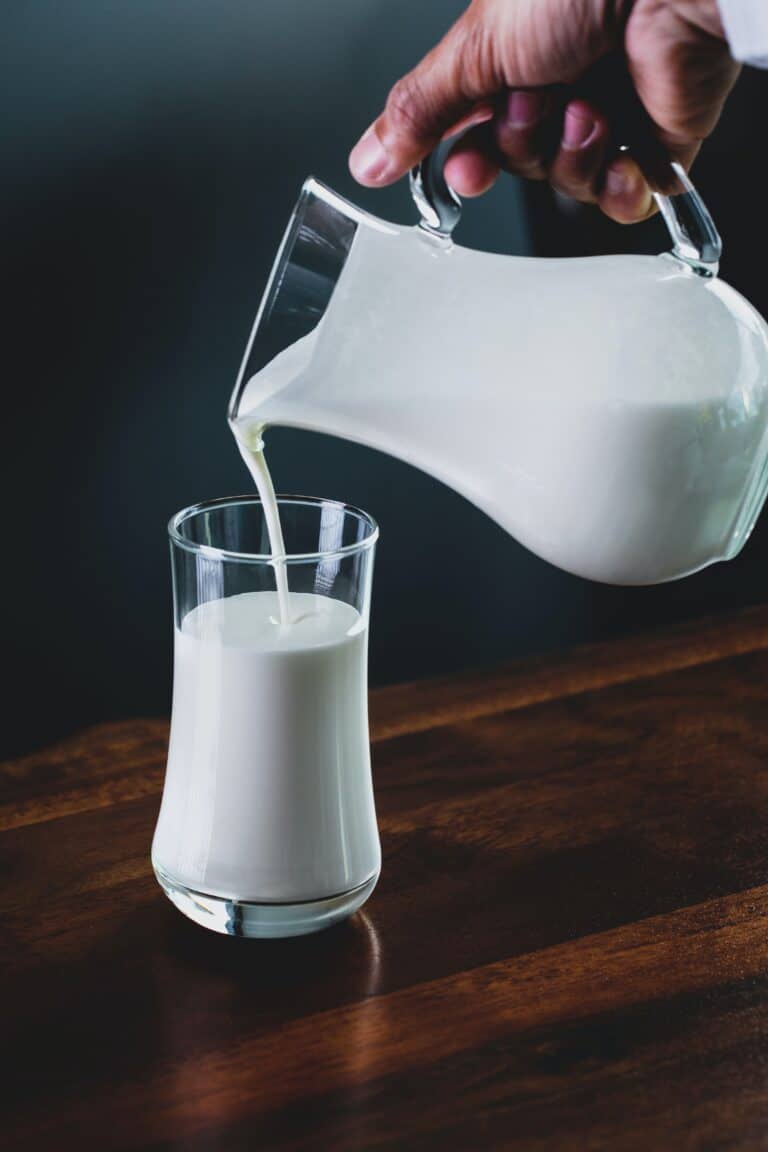Milk is an essential part of most people’s diets. It’s a terrific source of calcium. It’s used in a variety of recipes, and without it, cereal would be dry and tasteless.
But when you get to the store, you may have trouble choosing the milk product that’s best for you. With choices including skim, 1%, 2% and whole, it can be difficult to decide which to bring home from the market. While some types of milk have higher fat and calorie content, others are said to be more nutritious.
So which should you choose? This article will break it down for you.
Skim, 1%, 2%, Whole: What’s the Difference?
First, let’s start by getting one thing clear. All types of milk contain 13 essential nutrients. The nutrient counts vary slightly depending on the milk you are drinking. But if you are choosing whole milk because you think it’s more nutritious, you are getting very minor benefits if any at all.
So that leaves us with the fat and calorie breakdowns. These are as follows:
• Whole Milk: 150 calories, 3.25% fat
• 2%: 120 calories, 2% fat
• 1%: 100 calories, 1% fat
• Skim: 80 calories, 0% fat
The Controversial Fortification Process
Many people question the nutritional value of lower fat milks because they are fortified.
Low fat and skim milks are processed to reduce fat content. This causes them to lose some of their nutrition. The nutrients are restored through a fortification process that many find to be controversial due to the techniques and ingredients used.
While the fortification process is questionable, it can result in a product with even more nutrients.
Here is a breakdown of how each type of milk adds up in terms of the nutrients they contain.
• Whole Milk: 8 grams protein, 9% of the daily value of potassium, 27% of the daily value of calcium, 5% of the daily value of vitamin A, 24% of the daily value of vitamin D
• Low-fat Milk: 8 grams protein, 9% of the daily value of potassium, 29% of the daily value of calcium, 9% of the daily value of vitamin A, 29% of the daily value of vitamin D
• Skim Milk: 8 grams protein, 10% of the daily value of potassium, 29% of the daily value of calcium, 10% of the daily value of vitamin A, 25% of the daily value of vitamin D
New Study on Aging
If you are looking for anti-aging effects, you may want to stick to milks with a lower fat content. A 2020 study showed that drinking nonfat or 1% milk accounts for 4.5 years of reduced aging in adults.
Telomeres are nuclear end-caps of human chromosomes that are closely related to aging. They replicate and become shorter as time goes on. The older people get, the shorter their telomeres are.
The study revealed that people who drink high fat milk have shorter telomeres and show greater signs of aging.
So which milk should you drink? With pros and cons in associated with each, it may just come down to a matter of taste. Which will you be including in your diet?
Sugar is bad for you. Fruit is good for you. But fruit contains sugar. So how can both statements be true?
This article will break it down so you can determine if the sugar in fruit is good or bad.
Are Fruits Loaded with Sugar?
When we talk about harmful sugar, we are typically talking about table sugar and high fructose corn syrups which contain glucose and fructose, usually in equal measure. These ingredients can negatively affect metabolism if consumed excessively.
Fruit also contains fructose. So, is fruit bad for you?
The answer is no. The fructose content in fruit is so low that it will not harm your metabolism. It is safe to eat for most people.
Fruits Take Time to Chew and Digest
Fruits have a high fiber and water content. They give fruit chewing resistance meaning they take time to chew and digest. As a result, the fructose hits your liver slowly causing less of an impact.
In addition, the fiber and water in fruit are good for you. Fiber is beneficial to digestion. It reduces cholesterol, and it helps the body process sugar. It also makes you feel full, so you don’t snack as often.
Water hydrates the system helping maintain body temperature. It lubricates joints and protects the spinal cord. It also aids with excretion.
What About Fruit Juice?
While fresh fruit is good for you, you should be careful when consuming fruit juice and dried fruit. These should be added to the diet in limited quantities if at all.
While juice has the vitamins and antioxidants fruit contains, it does not require chewing. Therefore, it will hit your liver faster causing more of an impact.
Also, be warned. If you are drinking a fruit drink that is not 100% juice, the sugar content will be even higher and more detrimental to health.
If you enjoy fruit drinks, consider making yourself a smoothie with whole fruit, ice, and water. Smoothies are typically good for you but be careful of what else you add to the mix.
Dried fruit is also not a great option because, unlike fresh fruit, it does not have a high water content. And because dried fruit pieces are small, you are likely to consume larger quantities increasing your intake of sugar and calories. However, it is still better than eating no fruit at all.
When to Avoid Fruit
Some people are advised to avoid fruit because they are allergic to it or because it causes digestive issues. You may also want to eliminate it if you follow a low carb or ketogenic diet.
Ketogenic diets aim to reduce carbs, so your body changes the way it processes sugar into energy. Fruits tend to be high in carbs and are not recommended for this type of diet.
Conclusion
Fruit may contain sugar, but its water and fiber content balances any harmful effects. It is rich in vitamins, minerals and antioxidants making it a beneficial part of any diet. Which kind is your favorite?
In the past, we were told that too much cholesterol was a bad thing. More recently, we have learned that there’s such a thing as good cholesterol. So now it’s all about keeping good cholesterol and bad cholesterol in balance.
But what’s the difference between good and bad cholesterol? And how can you ensure that both are under control? This article will provide you with the information you need.
What’s the Difference Between Good and Bad Cholesterol?
Cholesterol is a waxy substance that builds up in the arteries. The two types of cholesterol are high-density lipoprotein (HDL) or ‘good cholesterol’ and low-density lipoprotein (LDL) or ‘bad cholesterol’.
HDL is good because it absorbs cholesterol and carries it to the liver removing it from the bloodstream before it can build up in the body. LDL takes cholesterol directly to the arteries. This can cause a plaque buildup that can result in a heart attack or stroke.
Triglycerides are another component found in good and bad cholesterol. They are stored as fat in the blood. They can build up in the bloodstream when you eat more calories than you burn. They also increase the risk of heart conditions.
How to Improve Your Cholesterol Levels
There are several things you can do to lower your triglycerides, reduce your LDL levels, and increase your HDL levels. These include:
Eating a Healthy Diet: Ensure your diet is optimized for the right cholesterol balance by reducing saturated fats, eliminating trans fats, eating foods that are rich in omega-3 fatty acids, increasing soluble fiber, and adding whey protein to your routine.
Engage in Physical Activity: Physical activity is great for increasing HDL levels in the body. You can improve your cholesterol by doing moderate exercise 30 minutes a day five days a week, or by engaging in vigorous physical activity 20 minutes a day three times a week.
Quit Smoking: Quitting smoking dramatically improves your HDL cholesterol levels. Within a year of quitting, your risk of heart disease will be 50% less than that of a smoker.
Drink Alcohol in Moderation: Moderate consumption of alcohol has been linked with higher HDL levels. The benefits aren’t strong enough to recommend alcohol to anyone who doesn’t drink. But if you do drink, it’s best to keep consumption under control.
Lose Weight: Even a few extra pounds can contribute to a high cholesterol level. Getting the right amount of physical activity and following a healthy diet will help to keep your weight regulated.
See a Doctor Regularly: Everyone should have their cholesterol levels checked regularly, especially if you are at high risk for heart disease. An LDL count of 100 or less is considered normal. HDL counts should be 40 or more for men, 50 or more for females. Your total cholesterol, including HDL, LDL, and triglycerides, should add up to no more than 200.
Cholesterol isn’t all bad. Taking the proper measures will keep LDL and triglycerides low while allowing good cholesterol to do its thing. How will you be promoting a healthy cholesterol balance in your diet?
Trying to determine what foods to eat to help you reach your fitness goals can be overwhelming. With so many diets on the market, it can be difficult to decide which one will be best for you. Nutrigenomics may be the key to finding the best foods to eat.
Nutrigenomics is a science that helps you determine an optimal meal plan based on your genes and how they interact with nutrients. Read on to find out how it can help you with weight loss, disease prevention, and general wellbeing.
What is Nutrigenomics?
Nutrigenomics determines how your genes will react to certain types of nutrition. For example, You FTO gene is related to metabolism. Variants in the gene will be telling of your body’s metabolic processes.
You can work with a dietician to find a meal routine that works best with your genetic makeup.
Nutrigenomics can also be valuable in disease prevention. Here are some examples of how they can help boost your wellness:
- If you are likely to develop high blood pressure or high cholesterol, you may choose a diet that is low in fats and sodium.
- If you eat a lot of sweets, you can create a diet that counters sweet cravings lowering your risk of diabetes.
- You can find out how your body responds to macronutrients like fat, protein, and carbohydrates to come up with a diet that’s ideal for weight loss.
- You can determine a diet that’s optimal for fat burn.
Nutrigenomic Testing
Nutrigenomic testing is as easy as swabbing the inside of your mouth. The swab is sent to a lab for testing. The lab may analyze 70 or more genes. You will get your results weeks later.
Although nutrigenomic tests are available in drug stores, you will need to work with a professional to understand your results. They will help you come up with a diet that will minimize your risk of disease and optimize your fitness levels.
Other Factors in that Affect Your Health
Genetics play a key role in your health and fitness. But it is not the only factor that weighs in.
The PREDICT 1 Study gathered data from 1000 participants, more than half of whom were twins. They ate specially designed muffins. Afterwards, testing was done to measure fat, insulin, and glucose levels in their blood.
Researchers also collected information on the participants’ exercise and sleep habits. They used stool samples to measure their gut bacteria.
Findings showed that:
- Macronutrients play a major role in blood sugar levels.
- Gut bacteria has the biggest effect on blood lipid levels.
- Genetics has a bigger impact on blood sugar levels than lipids do, but not as great of an impact as the nutrients you consume.
This indicates that genetics is only one part of what helps you reach your fitness goals. They are also affected by diet, exercise, sleep, and gut bacteria.
Conclusion
While nutrigenomics is not foolproof, it allows you to pinpoint the foods that are best for your health. It helps you come up with a plan uniquely suited to your body’s needs. It’s an effective way to lose weight, prevent disease and improve quality of life.
I grew up taking multi-vitamins and continued consuming them into adulthood. Then, one day my mother told me that they served me no benefit and may even be detrimental to my health. This was a surprise.
As a good daughter, I took what she said to heart. But I also needed to do some of my own digging.
So, what’s the verdict? Are multivitamins good or bad? Here’s what I found out.
What Do Multi-Vitamins Contain?
Multi-vitamins contain different nutrients depending on the brand. They may contain vitamins and minerals that assist in enzyme and hormone production.
Some may boost immunity and aid with nerve and organ function. The nutrients may also play a role in vital processes such as reproduction, growth, and maintenance.
In addition to vitamins and minerals, some multi-vitamins also contain fatty acids, herbs, and amino acids.
Multi-Vitamins and Heart Health
The Physicians Health Study researched 14,000 middle aged male doctors who took a daily multi-vitamin for over a decade and found it did not reduce the risk of heart attack and stroke in participants nor did it have any effect on mortality.
Another study tracked 1,708 heart attack survivors who took a multivitamin or a placebo for up to 55 months. The rate of heart conditions and heart-related deaths were similar for both groups.
Multi-Vitamins and Cancer
An analysis of research of over 450,000 people showed that multi-vitamins were not effective in lowering the risk of heart disease or cancer.
Other studies have shown that multi-vitamins can lower cancer risk in certain participants. However, a recent 2022 study showed that men (and not women) who consumed a daily multi-vitamin presented a higher cancer risk.
Multi-Vitamins and Mental Health
Some studies have shown that multivitamins can improve memory in older adults. Others show they can improve mood as vitamin deficiencies have been linked to low mood.
However, a 12-year study involving 5,947 men found that multivitamins did not reduce the risk of mental decline. Another study showed that they had no effect on mood.
Can Multivitamins Be Bad for You?
Multivitamins are generally safe, but they can cause unwanted side effects. For example, vitamin A and D toxicity can occur. It’s also possible that you can experience conditions if excess amounts of a vitamin are consumed.
You should also avoid fat-soluble vitamins as the fat is hard to flush out of your body and may accumulate in your liver.
The Final Verdict
With a lot of conflicting information on the consumption of multivitamins, you may be wondering, what’s the bottom line?
First, it’s worth noting that your doctor may prescribe certain supplements for certain conditions. For example, calcium may be recommended if you are at risk for bone loss. Iron may be prescribed if anemia is an issue. And folic acid is always recommended during pregnancy.
However, with multivitamins being a $12 billion a year industry, you may be better off spending your money on some nutrient-packed foods. Items like fruits, vegetables, and whole grains have been shown to be more beneficial than supplements.
After reading this article, will you be changing your supplemental choices?





